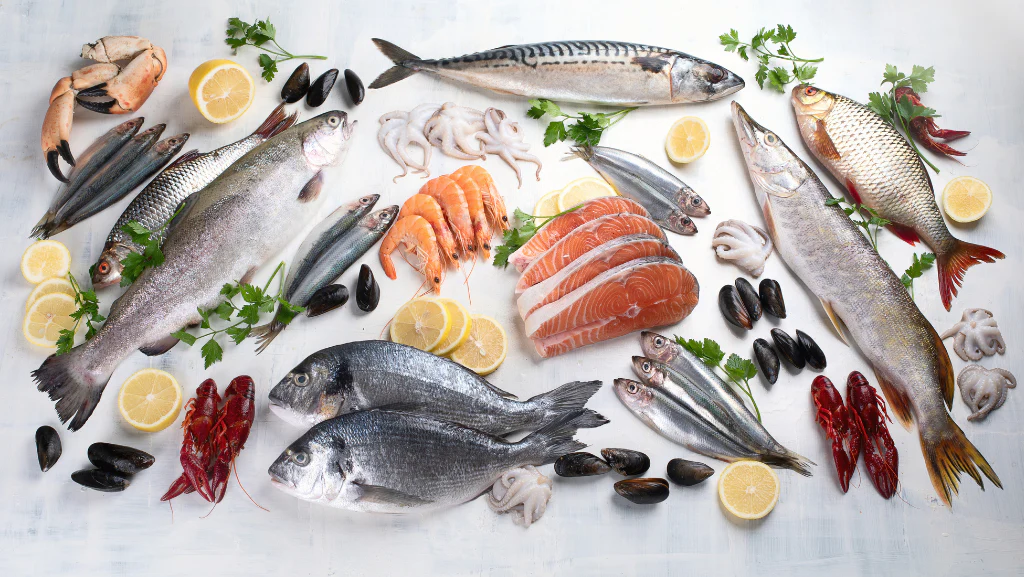How to Identify High-Quality Fresh Seafood
Identify High-Quality Fresh Seafood

The Importance of Fresh Seafood
Fresh seafood is not only tastier but also healthier. High-quality seafood retains more nutrients, has a firmer texture, and delivers better flavor. Fish, for example, is packed with omega-3 fatty acids, protein, and essential vitamins. However, seafood that is not fresh can spoil quickly and potentially pose a risk of foodborne illness. Knowing how to identify fresh seafood helps you avoid these risks while enjoying the best flavors the ocean has to offer.
What to Look for in Fresh Fish
When it comes to fish, there are several signs you can check to ensure that you’re getting the freshest catch possible. Below are key aspects to evaluate when buying fresh fish:
- Clear Eyes: Fresh fish will have clear, bright, and slightly bulging eyes. If the eyes appear cloudy, sunken, or discolored, it’s a sign that the fish is no longer fresh.
- Shiny, Moist Skin: The skin of a fresh fish should look shiny and feel moist. The scales should be tight and firmly attached to the body. If the fish’s skin appears dry, dull, or has patches where the scales are missing, it’s a red flag.
- Firm, Resilient Flesh: The flesh of a fresh fish should feel firm and spring back when pressed. If the fish feels soft or mushy, or if your finger leaves an indentation, the fish is likely past its prime.
How to Choose Fresh Shellfish
Shellfish such as shrimp, clams, mussels, and crabs require a slightly different approach when determining freshness. Here’s what to check for:
- Closed Shells: Live shellfish, such as clams, oysters, or mussels, should have tightly closed shells or snap shut when tapped. If the shells remain open, the shellfish is likely dead.
- Sweet, Oceanic Scent: Fresh shellfish should smell clean and have a slight oceanic aroma. Avoid shellfish with an overly fishy or ammonia-like odor, as this indicates spoilage.
- Firm Texture: For shellfish such as shrimp or scallops, the texture should be firm to the touch. Avoid shellfish that feels slimy, mushy, or sticky.
- Vibrant Color: Fresh shellfish will have bright, vibrant colors. Shrimp should be translucent with a slight sheen, while scallops should be creamy white or slightly pink. Dull or discolored shellfish is usually a sign of spoilage.
Tips for Buying Seafood from Markets
Shopping for seafood in a market can be overwhelming, especially if you’re not sure what to look for. Here are some general tips for navigating your next visit:
- Know Your Source: Always buy seafood from a reputable fishmonger or market known for high-quality, fresh products. Ask where the seafood comes from and how recently it was caught.
- Look for Signs of Freshness: Fresh seafood should be displayed on a bed of ice and kept cold. Fish should not be in direct contact with water.
- Don’t Be Afraid to Ask Questions: Ask about the catch date, how to store the seafood, and how to prepare it. A knowledgeable seller will guide you in choosing the freshest seafood.
Premium Frozen Seafood at Your Doorstep

Seafood Direct, a UK-based online seafood delivery service, is a family-run business with over 50 years of expertise in the fish industry. Sourcing seafood from around the globe, Seafood Direct ensures that customers receive high-quality, premium seafood delivered directly to their doorsteps. They offer an impressive selection of frozen products, allowing you to enjoy the convenience of top-quality seafood without sacrificing freshness.
How to Store Fresh Seafood at Home
Once you’ve bought your seafood, proper storage is crucial to maintaining its freshness. Here are some tips to keep your seafood in peak condition:
- Keep It Cold: Seafood should be stored in the coldest part of your refrigerator, ideally at 32°F (0°C). Place it on a plate and cover with a damp cloth to keep it moist.
- Eat It Quickly: Fresh seafood is best eaten within one to two days of purchase. If you can’t consume it that quickly, freezing is the best option.
- Wrap Properly for Freezing: Wrap seafood tightly in plastic wrap or aluminum foil, then place it in an airtight container or freezer bag to prevent freezer burn and maintain quality.
Conclusion
Identifying high-quality fresh seafood doesn’t have to be difficult. By paying attention to key indicators like the appearance, smell, and texture, you can ensure that you’re buying the best seafood available. Whether you’re shopping for fish, shellfish, or frozen products, following these tips will help you enjoy delicious, fresh seafood at its finest. And with convenient options like Seafood Direct, you can have top-quality seafood delivered straight to your door, making it easier than ever to enjoy the flavors of the ocean.




